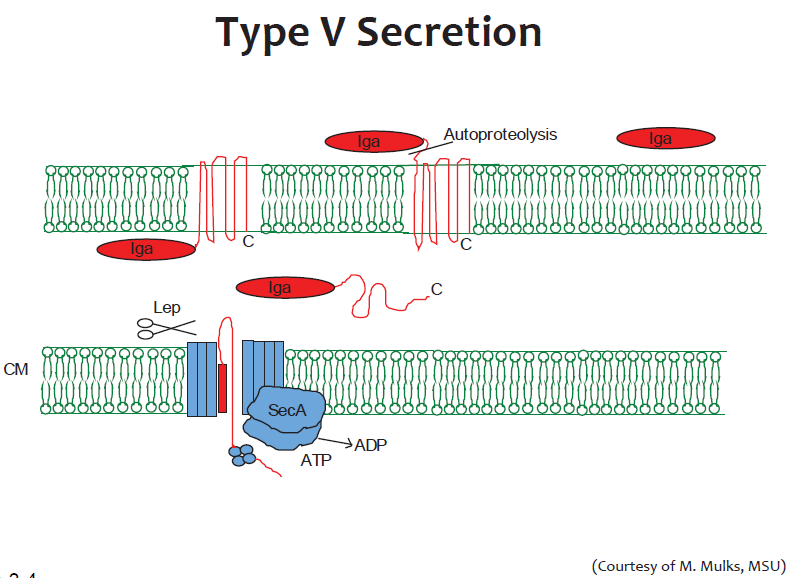Type V Secretion System
Type v secretion system. The type V secretion system T5SS is like the T2SS a two-step process secretion system. By signing up youll get thousands of step-by-step solutions to your homework questions. A The type V secretion system T5SS autotransporter type Va carboxy-terminal domain CTD the EstA translocator is inserted into the outer membrane OM.
Type V secretion denotes a variety of secretion systems that cross the outer membrane in Gram-negative bacteria but that depend on the Sec machinery for transport through the inner membrane. The Type VI Secretion System - YouTube. This specific secretion system can transport both DNA and proteins.
The type V secretion system is a minimal machine. Depending on the exact domain architecture of the protein type V secretion systems can be further separated into sub-groups termed type Va through e and possibly another recently identified subtype termed Vf. However whether the T4SS is implicated or not during the infection process remains unknown.
Type V secretion system T5SS substrates are unique in that unlike other secreted substrates which cross the bacterial membrane with the help of a dedicated secretion apparatus or membrane channel they secrete themselves. 2019 Meuskens et al. Type VI secretion system.
Type VI secretion system effectors are loaded onto a secreted tail tube composed of stacked hexameric rings of Hcp proteins which are capped by a spike complex comprising a VgrG trimer and a PAAR repeat-containing protein hereafter referred to as PAAR that sharpens the tip of this structure Shneider et al 2013. An example of a pathogenic bacteria that utilizes the type IV secretion system is Helicobacter pylori. The type VI secretion machinery T6SS is a recently characterized secretion system that appears to constitute a phage-tail-spike-like injectisome that has the potential to introduce effector proteins directly into the cytoplasm of host cells analogous to the T3SS and T4SS machineries.
However the exact mechanisms this process utilizes is unknown but there is a general understanding. The Type V secretion system T5SS comprises diverse branches the autotransporter AT or Type Va and Type Vc pathway and the two-partner secretion TPS or. The type IV secretion system T4SS is one of several types of secretion systems which microorganisms use for the transport of macromolecules such as proteins and.
Bacteria secrete proteins for different purposes such as communication virulence functions adhesion to surfaces nutrient acquisition or growth inhibition of competing bacteria. Protein secretion system Autotransporters Type V secretion system Outer membrane proteins Protein translocation Autochaperone domain diderm-LPS Gram-negative bacteria INTRODUCTION Bacteria can secrete proteins by numerous molecular machineriesIn this field it is of key importance to differentiate export protein transport across the cytoplasmic membrane from.
BACKGROUND OF SECRETION SYSTEMS There are six different types of secretion systems in bacteria Type I Type II Type III Type IV Type V and Type VI Type I and IV are found in both gram-negative and gram-positive bacteria All other types of secretion systems are found only in gram-negative bacteria Type III secretion system TTSS is responsible for interactions with host cell.
Or rather it secretes part of it. Recent studies have shown that a type IV secretion system T4SS gene cluster is exclusively found in strains of V. The type IV secretion system T4SS is one of several types of secretion systems which microorganisms use for the transport of macromolecules such as proteins and. The type V secretion system is a minimal machine. Type VI secretion system. The Type V secretion system T5SS comprises diverse branches the autotransporter AT or Type Va and Type Vc pathway and the two-partner secretion TPS or. The type V secretion system T5SS is like the T2SS a two-step process secretion system. How do Type V secretion systems work. An example of a pathogenic bacteria that utilizes the type IV secretion system is Helicobacter pylori.
The type VI secretion machinery T6SS is a recently characterized secretion system that appears to constitute a phage-tail-spike-like injectisome that has the potential to introduce effector proteins directly into the cytoplasm of host cells analogous to the T3SS and T4SS machineries. Protein secretion system Autotransporters Type V secretion system Outer membrane proteins Protein translocation Autochaperone domain diderm-LPS Gram-negative bacteria INTRODUCTION Bacteria can secrete proteins by numerous molecular machineriesIn this field it is of key importance to differentiate export protein transport across the cytoplasmic membrane from. However whether the T4SS is implicated or not during the infection process remains unknown. Simplest case a type V secretion system consists of only one polypeptide chain with a b-barrel translocator domain in the membrane and an extracellular passenger or effector region. The type IV secretion system utilizes a process similar to this. A The type V secretion system T5SS autotransporter type Va carboxy-terminal domain CTD the EstA translocator is inserted into the outer membrane OM. Following Sec-dependent secretion into the periplasm the proteins are secreted through the outer membrane utilizing the translocase function of the C-terminal portion of the protein auto-transporters or another helper protein two-partner secretion.













































Posting Komentar untuk "Type V Secretion System"